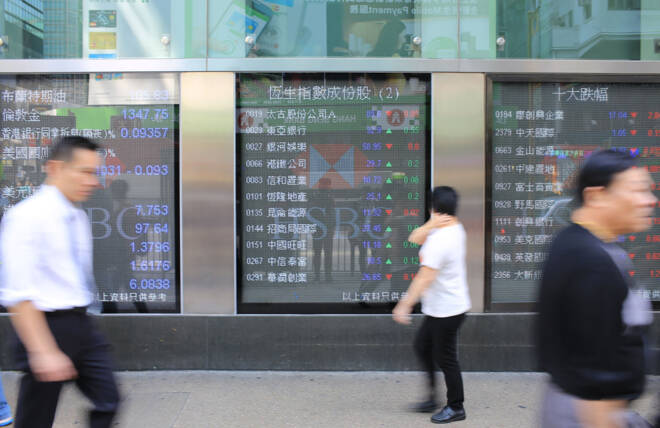Advertisement
Advertisement
Hang Seng Index to End Four Year Losing Streak as Nikkei and ASX 200 See Red
By:
Key Points:
- Hang Seng Index rises 0.58% on strong PMI data, while Mainland China markets falter on US tariff concerns.
- ASX 200 slides 0.57%, mirroring US losses as Aussie banks and mining stocks decline under yield pressure.
- Nikkei 225 dips 0.96% as strong Yen impacts Japanese tech and auto stocks; Nissan leads losses at 5.73%.
US Markets Extend Losses Amid Elevated Yields
Here’s a breakdown of the Monday, December 30, session in US equity markets.
US equity markets extended their losses from Friday, December 27. The Nasdaq Composite Index and the S&P 500 slid by 1.19% and 1.07%, respectively, while the Dow posted a 0.97% loss.
Investors booked profits for the second straight session, driven by persistently high US Treasury yields. Market jitters about a less dovish Fed rate path drove investors to exit positions as 2024 drew nearer to a close.
Bitcoin (BTC) continued its retreat from the December 17 all-time high of $108,231. On Monday, it fell to a session low of $91,269. The pullback impacted demand for crypto-related stocks, which continued to weigh on the Nasdaq.
MicroStrategy (MSTR) tumbled 8.19%, while Marathon Holdings (MARA) slid by 6.24%.
Monday’s US market losses will likely set the tone for the Tuesday Asian session.
US Data Supports a Less Dovish Fed Rate Path
On Monday, pending home sales and Dallas Fed Manufacturing Index numbers painted a rosier picture of the US economy. Pending home sales climbed 2.2% in November, building on October’s 1.8% increase. Economists view the housing market as a barometer for the US economy. Rising demand may drive house prices and rents higher, fueling housing services and demand-driven inflation.
The Dallas Fed Manufacturing Index also surprised on the upside, climbing 3.4% in December. Economists expected a 0.4% decline after falling 2.7% in November.
These indicators reinforced expectations of a more hawkish Federal Reserve heading into 2025.
China NBS Private Sector PMIs Send Mixed Signals
On Tuesday, December, 31, China’s NBS private sector PMIs drove demand for Hong Kong-listed stocks. The NBS Non-Manufacturing PMI increased from 50.0 to 52.2, while the Manufacturing PMIs slipped to 50.1. Despite the weaker Manufacturing PMI, the sector crucially expanded for the third month.
CN Wire commented on December’s Manufacturing PMI data, stating,
“In December, the combined effects of macroeconomic policies continued to manifest, with the Manufacturing PMI remaining at 50.1%, marking the third consecutive month above the critical threshold.”
Assessing the supply and demand environment, CN Wire stated,
“The Production Index stood at 52.1%, a slight decrease of 0.3 percentage points from the previous month, while the New Orders Index rose by 0.2 percentage points to 51.0%. Both indices remained above the critical threshold, indicating sustained growth in production and market demand.”
Hang Seng Index Advances on PMI Data
In Asian markets, the Hang Seng Index advanced by 0.58% on Tuesday morning. China’s PMI data fueled a recovery from early losses.
The real estate sector led the gains, with the Hang Seng Mainland Properties Index advancing by 1.25%. The Hang Seng Tech Index edged 0.07% higher, contributing to the gains. Tech giants Alibaba (9988) rallied 1.52%, while Baidu (9888) slid by 1.37%.
However, Mainland China’s CSI 300 and Shanghai Composite declined by 0.28% and 0.17%, respectively. Market concerns about the impact of US tariffs on China’s economy left the indexes in negative territory.
Nikkei Index Falls as Yen Finds Buyers
Meanwhile, Japan’s Nikkei Index declined by 0.96% on Tuesday morning. US market losses and a weaker USD/JPY reduced demand for Japanese stocks. A stronger Japanese Yen may weigh on overseas earnings, affecting stock prices.
Tech stocks extended their losses from Monday, tracking the Nasdaq’s pullback. Tokyo Electron (8035) and Softbank Group (9984) fell by 0.80% and 0.75%, respectively. Sony Corp. (6758) succumbed to a stronger Yen, dropping by 1.40%.
However, Nissan Motor Corp. (7201) led the losses for the second session, sliding by 5.73% amid ongoing uncertainty about a potential merger with Honda Motor Corp. (7267).
ASX 200 Tracks US Markets into the Red
Australia’s ASX 200 Index also struggled in the year’s final session, falling 0.57%. The Index mirrored Monday’s US market losses. Banking, gold, mining, and tech sectors drove the decline.
The S&P/ASX All Technology Index dropped by 0.91%, while Northern Star Resources Ltd. (NST) was down 0.58%, pressured by gold’s 0.58% loss on Monday.
Aussie banks Commonwealth Bank of Australia (CBA) and ANZ (ANZ) saw declines of 0.88% and 0.87%, respectively. Higher US Treasury yields continued to curb demand for high-yielding Aussie bank stocks.
Outlook
As the year draws to a close, profit-taking and central bank commentary may drive volatility. Investors should also watch for US tariff developments and Beijing’s potential stimulus measures.
For in-depth analysis of the Hang Seng Index and global market trends, click here.
About the Author
Bob Masonauthor
With over 28 years of experience in the financial industry, Bob has worked with various global rating agencies and multinational banks. Currently he is covering currencies, commodities, alternative asset classes and global equities, focusing mostly on European and Asian markets.
Did you find this article useful?
Latest news and analysis
Advertisement
